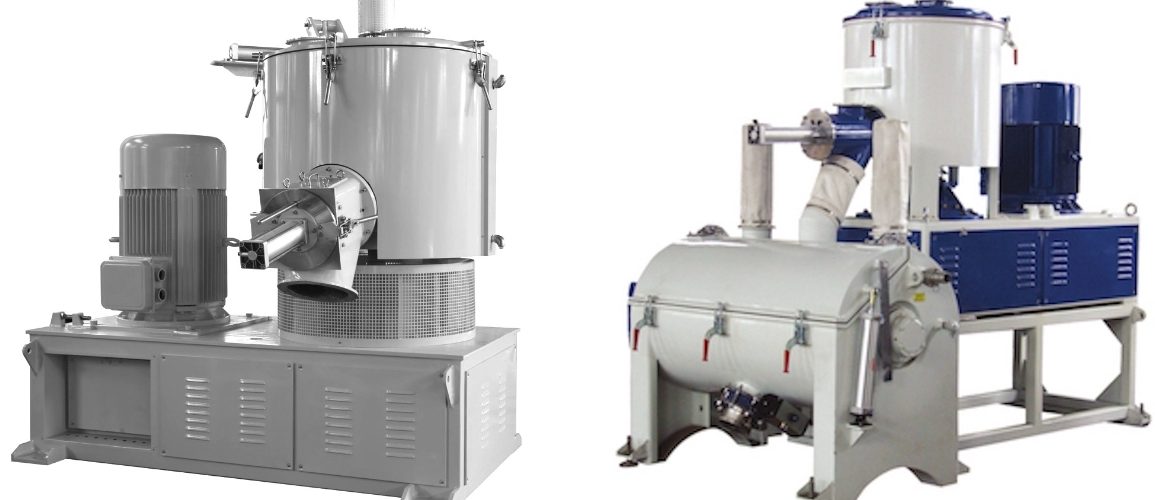5 key points to keep the color masterbatch high speed mixing process correct
High-speed mixing is to put pigments, dispersants, carriers, etc. into a high-speed mixer for high-speed mixing according to the designed formula. It is an extremely important first production link in the production of color masterbatches.
Practical experience has proved that the pre-wetting of the pigment in the high-speed mixing process largely determines the final dispersibility of the color masterbatch product.
1. The quantity and rotation speed of the material carried by the high-mixing process
The high-mix loading capacity is related to the bulk volume of high-mix materials. Too much or too little loading will affect the normal operation of high-mixing, and it is difficult to achieve good high-mixing quality. The high-mixing speed is generally divided into two gears: low-speed start-up to reduce power load; high-speed mixing and moistening and discharging, with exceptions for special structures.
2. High mixing process temperature and time
If the high-mixing process does not have a certain temperature, it only plays the role of mixing at room temperature, and the initial wetting of the pigment cannot be achieved, and the key role of the high-mixing process is lost. There are two ways for the heat source of the high-mix process:
(1) To transfer the temperature through the high-mixer barrel oil heating, it is necessary to set the temperature control;
- The temperature is transferred through the high-speed stirring and friction of the material, but the first pot of high-mixing takes a long time to accumulate the temperature.
The time required for high mixing is the time required for the material to “cook”—the dispersant melts and coats the carrier. It is related to the way of temperature transmission, the composition of materials, and the weather. The molecular weight of most dispersing and moisturizing agents is relatively small, and the more dispersing and moisturizing agents, the shorter the completion time of high mixing. Generally considered to be controlled at 15-30min. The abnormality of too long or too short time can promote the perfection of the formula, and finally the time required to reach the high mixing quality standard.
3.The high-mixing process requires careful observation. There are two ways to observe:
(1) A transparent observation port is provided to observe the changing state of the material at any time, but the transparent window is easily contaminated and affects the observation effect;
(2) Indirect judgment through current changes.
At the beginning of high mixing, due to inertia, the resistance is very large, and the power equipment is started with high load, causing the current to jump up instantly.After entering the normal constant speed operation, since the material is in a loose state and moves at a constant speed, the load of the power equipment is very light, and the current decreases accordingly. As the temperature increases, the dispersing wetting agent begins to melt gradually, and the adhesion state between the materials becomes more and more serious, which causes the motor load to increase. At this time, the current pointer gradually rises in a wave-like jitter.
4. High-mix quality judgment
After the high-mixing treatment, if the material is basically in the original loose state, there is a large amount of dry powder flying, which is generally judged as unqualified and needs to be reworked to continue high-mixing. If a large lump is formed, or even hardened at the bottom of the barrel, or if it is loose when discharging, and when it forms large lumps after being stored for several hours, it has to be stirred and broken again.
It is generally believed that the most ideal state is that there is basically no dust, and the overall appearance is roughly granular. The pigments are all wetted and then stick to the carrier. Even the largest particles can smoothly enter the screw granulation, which is the most ideal high mixing quality. In addition, special attention should be paid to the fact that the high mixing process is a process of wetting the pigment, and the wetting agent replaces the air and water on the surface of the pigment, so the removal of water should be considered to ensure the quality.
5. High-mix environmental protection requirements
High-mixed material pouring, stirring and discharging will generate certain dust and gas, which is the focus of environmental protection control.
At present, most enterprises install inverted funnel-shaped dust collection equipment above the high-mixing equipment, suck most of the dust and gas into the pipeline through suction, and transmit and filter the gas for treatment and release, and solid waste is collected and disposed of.
Source from Plaschain
